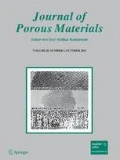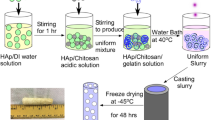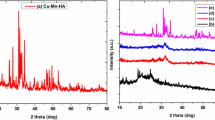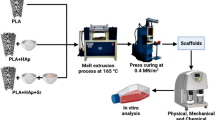Abstract
Carbonate apatite (CO3Ap) scaffolding has been widely used for bone repair and replacement due to its excellent osteoconductivity and resorbability in bone defects. However, the application of the porous scaffold has been limited by its brittleness. Here, CO3Ap scaffolds coated with 1, 3 and 5 wt% of sodium alginate (SA) and bovine gelatine (BG) were fabricated to improve the mechanical properties of the porous scaffold. Limited studies have been done on a CO3Ap scaffold coated with a natural polymer layer. Here, a CO3Ap scaffold was fabricated through the phase transformation from β-tricalcium phosphate (β-TCP) to CO3Ap using a hydrothermal method. Fourier-transform infrared (FTIR) analysis confirmed the presence of both SA and BG functional groups on the CO3Ap scaffold. Five wt% of SA and BG improved the compressive strength of the uncoated CO3Ap scaffold by 34% and 46%, respectively. The SA coating was found to enhance the compressive strength of the CO3Ap scaffold compared to the BG coating due to its high viscosity. Furthermore, the compressive strength of the scaffold increased by 40% after undergoing a silanization process and being coated with SA. These results indicate that the use of a silane treatment improved the chemical bonding between the CO3Ap scaffold and SA coating. This process increased the adhesion between the SA coating and the scaffold and improved the compressive strength.











Similar content being viewed by others
References
S.V. Dorozhkin, Calcium orthophosphates as bioceramics: state of the art. J. Funct. Biomater. 1, 22–107 (2010). https://doi.org/10.3390/jfb1010022
N. Ahmad, K. Tsuru, M.L. Munar, M. Maruta, S. Matsuya, K. Ishikawa, Effect of precursor’s solubility on the mechanical property of hydroxyapatite formed by dissolution-precipitation reaction of tricalcium phosphate. Dent. Mater. J. 31, 995–1000 (2012). https://doi.org/10.4012/dmj.2012-176
Y. Sugiura, K. Tsuru, K. Ishikawa, Fabrication of carbonate apatite foam based on the setting reaction of α-tricalcium phosphate foam granules. Ceram. Int. 42, 204–210 (2015). https://doi.org/10.1016/j.ceramint.2015.08.081
Y. Kang, A. Scully, D.A. Young, S. Kim, H. Tsao, M. Sen, Y. Yang, Enhanced mechanical performance and biological evaluation of a PLGA coated β-TCP composite scaffold for load-bearing applications. Eur. Polym. J. 47, 1569–1577 (2011). https://doi.org/10.1016/j.eurpolymj.2011.05.004
T. Furusawa, T. Minatoya, T. Okudera, Y. Sakai, T. Sato, Y. Matsushima, H. Unuma, Enhancement of mechanical strength and in vivo cytocompatibility of porous β-tricalcium phosphate ceramics by gelatin coating. Int. J. Implant Dent. 2, 4 (2016). https://doi.org/10.1186/s40729-016-0037-3
J. Wang, D. Li, T. Li, J. Ding, J. Liu, B. Li, X. Chen, Gelatin tight-coated poly(lactide-co-glycolide) scaffold incorporating rhBMP-2 for bone tissue engineering. Materials (Basel) 8, 1009–1026 (2015). https://doi.org/10.3390/ma8031009
S.-M. Kim, S.-A. Yi, S.-H. Choi, K.-M. Kim, Y.-K. Lee, Gelatin-layered and multi-sized porous β-tricalcium phosphate for tissue engineering scaffold. Nanoscale Res. Lett. 7, 78 (2012). https://doi.org/10.1186/1556-276X-7-78
X.H. Yong, M.I. Mazlam, N. Ahmad, Fabrication and characterization of porous biphasic β-tricalcium phosphate/carbonate apatite alginate coated scaffolds. Ceram. Int. 44, 9499–9505 (2018). https://doi.org/10.1016/j.ceramint.2018.02.168
N.A.S. Zairani, M. Jaafar, N. Ahmad, K. Abdul Razak, Fabrication and characterization of porous β-tricalcium phosphate scaffolds coated with alginate. Ceram. Int. 42, 5141–5147 (2016). https://doi.org/10.1016/j.ceramint.2015.12.034
Z.M. Huang, Y.Z. Zhang, M. Kotaki, S. Ramakrishna, A review on polymer nanofibers by electrospinning and their applications in nanocomposites. Compos. Sci. Technol. 63, 2223–2253 (2003). https://doi.org/10.1016/S0266-3538(03)00178-7
L. Ghasemi-Mobarakeh, M.P. Prabhakaran, M. Morshed, M.H. Nasr-Esfahani, S. Ramakrishna, Electrospun poly(ε-caprolactone)/gelatin nanofibrous scaffolds for nerve tissue engineering. Biomaterials 29, 4532–4539 (2008). https://doi.org/10.1016/j.biomaterials.2008.08.007
K. Ghosal, C. Agatemor, Z. Špitálsky, S. Thomas, E. Kny, Electrospinning tissue engineering and wound dressing scaffolds from polymer-titanium dioxide nanocomposites. Chem. Eng. J. 358, 1262–1278 (2019). https://doi.org/10.1016/j.cej.2018.10.117
H. Alenezi, M.E. Cam, M. Edirisinghe, Experimental and theoretical investigation of the fluid behavior during polymeric fiber formation with and without pressure. Appl. Phys. Rev. 6, 041401 (2019). https://doi.org/10.1063/1.5110965
G. Li, L. Zhang, C. Wang, X. Zhao, C. Zhu, Y. Zheng, Y. Wang, Y. Zhao, Y. Yang, Effect of silanization on chitosan porous scaffolds for peripheral nerve regeneration. Carbohydr. Polym. 101, 718–726 (2014). https://doi.org/10.1016/j.carbpol.2013.09.064
O.G. Cisneros-Pineda, W. Herrera Kao, M.I. Loría-Bastarrachea, Y. Veranes-Pantoja, J.V. Cauich-Rodríguez, J.M. Cervantes-Uc, Towards optimization of the silanization process of hydroxyapatite for its use in bone cement formulations. Mater. Sci. Eng. C. 40, 157–163 (2014). https://doi.org/10.1016/j.msec.2014.03.064
S. Joughehdoust, A. Behnamghader, M. Imani, M. Daliri, A.H. Doulabi, E. Jabbari, A novel foam-like silane modified alumina scaffold coated with nano-hydroxyapatite-poly(ε-caprolactone fumarate) composite layer. Ceram. Int. 39, 209–218 (2013). https://doi.org/10.1016/j.ceramint.2012.06.011
J. Venkatesan, I. Bhatnagar, P. Manivasagan, K.-H. Kang, S. Kim, Alginate composites for bone tissue engineering: a review. Int. J. Biol. Macromol. 72C, 269–281 (2014). https://doi.org/10.1016/j.ijbiomac.2014.07.008
T. Nguyen, B. Lee, Fabrication and characterization of cross-linked gelatin. J. Biomed. Sci. Eng. 3, 1117–1124 (2010). https://doi.org/10.4236/jbise.2010.312145
F. Darus, M. Jaafar, N. Ahmad, Preparation of carbonate apatite scaffolds using different carbonate solution and soaking time. Process. Appl. Ceram. 13, 139–148 (2019)
L.J. Yang, Y.C. Ou, The micro patterning of glutaraldehyde (GA)-crosslinked gelatin and its application to cell-culture. Lab Chip 5, 979–984 (2005). https://doi.org/10.1039/b505193b
L.T. Bang, K. Tsuru, M. Munar, K. Ishikawa, R. Othman, Mechanical behavior and cell response of PCL coated α-TCP foam for cancellous-type bone replacement. Ceram. Int. 39, 5631–5637 (2013). https://doi.org/10.1016/j.ceramint.2012.12.079
W. Li, H. Wang, Y. Ding, E.C. Scheithauer, O.-M. Goudouri, A. Grünewald, R. Detsch, S. Agarwal, A.R. Boccaccini, Antibacterial 45S5 Bioglass®-based scaffolds reinforced with genipin cross-linked gelatin for bone tissue engineering. J. Mater. Chem. B. 3, 3367–3378 (2015). https://doi.org/10.1039/C5TB00044K
F. Darus, R.M. Isa, N. Mamat, M. Jaafar, Techniques for fabrication and construction of three-dimensional bioceramic scaffolds: effect on pores size, porosity and compressive strength. Ceram. Int. 44, 18400–18407 (2018). https://doi.org/10.1016/j.ceramint.2018.07.056
L.T. Bang, S. Ramesh, J. Purbolaksono, B.D. Long, H. Chandran, R. Othman, Development of a bone substitute material based on alpha-tricalcium phosphate scaffold coated with carbonate. Biomed. Mater. 10, 45011 (2015). https://doi.org/10.1088/1748-6041/10/4/045011
I.Y. Pieters, N.M.F. Van den Vreken, H.A. Declercq, M.J. Cornelissen, R.M.H. Verbeeck, Carbonated apatites obtained by the hydrolysis of monetite: influence of carbonate content on adhesion and proliferation of MC3T3-E1 osteoblastic cells. Acta Biomater. 6, 1561–1568 (2010). https://doi.org/10.1016/j.actbio.2009.11.002
S. Kannan, S.I. Vieira, S.M. Olhero, P.M.C. Torres, S. Pina, O.A.B. Da Cruz, E. Silva, J.M.F. Ferreira, Synthesis, mechanical and biological characterization of ionic doped carbonated hydroxyapatite/β-tricalcium phosphate mixtures. Acta Biomater. 7, 1835–1843 (2011). https://doi.org/10.1016/j.actbio.2010.12.009
M. Nagpal, S.K. Singh, D. Mishra, Synthesis characterization and in vitro drug release from acrylamide and sodium alginate based superporous hydrogel devices. Int. J. Pharm. Investig. 3, 88–94 (2013). https://doi.org/10.4103/2230-973X.119215
S. Adzila, N. Azimahmustaffa, The effect of sodium alginate on the properties of hydroxyapatite. Procedia Eng. 184, 442–448 (2017). https://doi.org/10.1016/j.proeng.2017.04.115
D. Das, S. Zhang, I. Noh, Synthesis and characterizations of alginate- α-tricalcium phosphate microparticle hybrid film with flexibility and high mechanical property as a biomaterial. Biomed. Mater. 13, 025008 (2018). https://doi.org/10.1088/1748-605X/aa8fa1
S. Hermanto, L.O. Sumarlin, W. Fatimah, Differentiation of bovine and porcine gelatin based on spectroscopic and electrophoretic analysis. J. Food Pharm. Sci. 1, 68–73 (2013)
S. Dorozhkin, T. Ajaal, Toughening of porous bioceramic scaffolds by bioresorbable polymeric coatings. Proc. Inst. Mech. Eng. Part H J. Eng. Med. 223, 459–470 (2009). https://doi.org/10.1243/09544119JEIM513
G. Hannink, J.J.C. Arts, Bioresorbability, porosity and mechanical strength of bone substitutes: what is optimal for bone regeneration? Injury 42, S22–S25 (2011). https://doi.org/10.1016/j.injury.2011.06.008
N.H. Nordin, Z. Ahmad, Monitoring chemical changes on the surface of borosilicate glass covers during the silanisation process. J. Phys. Sci. 26, 11–22 (2015)
J. Lee, I.K. Kim, T.G. Kim, Y.H. Kim, J.C. Park, Y.J. Kim, S.Y. Choi, M.Y. Park, Biocompatibility and strengthening of porous hydroxyapatite scaffolds using poly(l-lactic acid) coating. J. Porous Mater. 20, 719–725 (2013). https://doi.org/10.1007/s10934-012-9646-2
A.L. Torres, V.M. Gaspar, I.R. Serra, G.S. Diogo, R. Fradique, A.P. Silva, I.J. Correia, Bioactive polymeric-ceramic hybrid 3D scaffold for application in bone tissue regeneration. Mater. Sci. Eng. C 33, 4460–4469 (2013). https://doi.org/10.1016/j.msec.2013.07.003
J.J. Li, E.S. Gil, R.S. Hayden, C. Li, S.I. Roohani-Esfahani, D.L. Kaplan, H. Zreiqat, Multiple silk coatings on biphasic calcium phosphate scaffolds: effect on physical and mechanical properties and in vitro osteogenic response of human mesenchymal stem cells. Biomacromolecules 14, 2179–2188 (2013). https://doi.org/10.1021/bm400303w
A. Sadiasa, M.S. Kim, B.T. Lee, Poly(lactide-co-glycolide acid)/biphasic calcium phosphate composite coating on a porous scaffold to deliver simvastatin for bone tissue engineering. J. Drug Target. 21, 719–729 (2013). https://doi.org/10.3109/1061186X.2013.811512
Acknowledgements
The authors would like to thank the Trans Disciplinary Research Grant Scheme (TRGS), Grant No. 6761004 for financial support and also School of Materials and Mineral Resources Engineering Campus for laboratory cooperation.
Author information
Authors and Affiliations
Corresponding author
Ethics declarations
Conflict of interest
The authors declare that they have no conflict of interest.
Additional information
Publisher's Note
Springer Nature remains neutral with regard to jurisdictional claims in published maps and institutional affiliations.
Rights and permissions
About this article
Cite this article
Darus, F., Jaafar, M. Enhancement of carbonate apatite scaffold properties with surface treatment and alginate and gelatine coating. J Porous Mater 27, 831–842 (2020). https://doi.org/10.1007/s10934-019-00848-1
Published:
Issue Date:
DOI: https://doi.org/10.1007/s10934-019-00848-1




